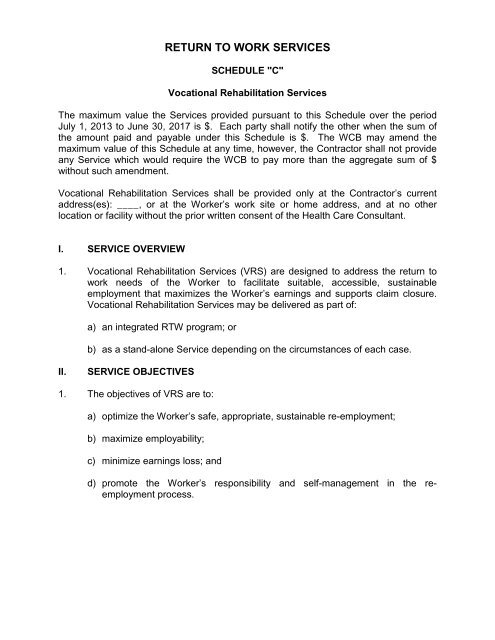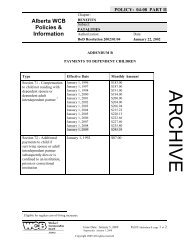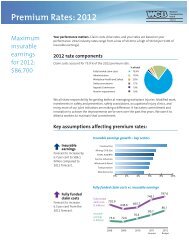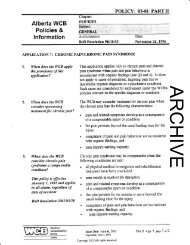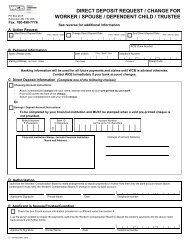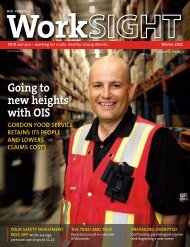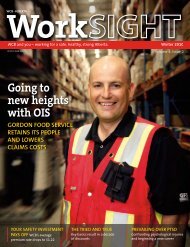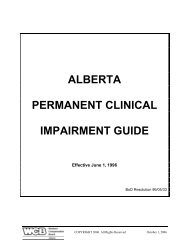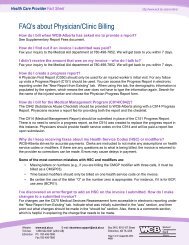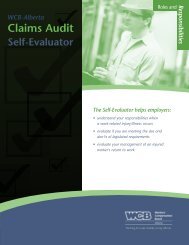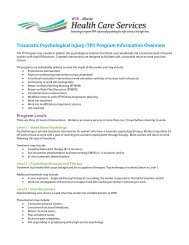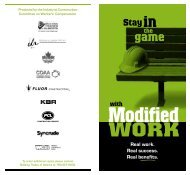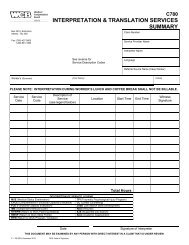RETURN TO WORK SERVICES - Workers' Compensation Board
RETURN TO WORK SERVICES - Workers' Compensation Board
RETURN TO WORK SERVICES - Workers' Compensation Board
Create successful ePaper yourself
Turn your PDF publications into a flip-book with our unique Google optimized e-Paper software.
<strong>RETURN</strong> <strong>TO</strong> <strong>WORK</strong> <strong>SERVICES</strong><br />
SCHEDULE "C"<br />
Vocational Rehabilitation Services<br />
The maximum value the Services provided pursuant to this Schedule over the period<br />
July 1, 2013 to June 30, 2017 is $. Each party shall notify the other when the sum of<br />
the amount paid and payable under this Schedule is $. The WCB may amend the<br />
maximum value of this Schedule at any time, however, the Contractor shall not provide<br />
any Service which would require the WCB to pay more than the aggregate sum of $<br />
without such amendment.<br />
Vocational Rehabilitation Services shall be provided only at the Contractor’s current<br />
address(es): ____, or at the Worker’s work site or home address, and at no other<br />
location or facility without the prior written consent of the Health Care Consultant.<br />
I. SERVICE OVERVIEW<br />
1. Vocational Rehabilitation Services (VRS) are designed to address the return to<br />
work needs of the Worker to facilitate suitable, accessible, sustainable<br />
employment that maximizes the Worker’s earnings and supports claim closure.<br />
Vocational Rehabilitation Services may be delivered as part of:<br />
a) an integrated RTW program; or<br />
b) as a stand-alone Service depending on the circumstances of each case.<br />
II.<br />
SERVICE OBJECTIVES<br />
1. The objectives of VRS are to:<br />
a) optimize the Worker’s safe, appropriate, sustainable re-employment;<br />
b) maximize employability;<br />
c) minimize earnings loss; and<br />
d) promote the Worker’s responsibility and self-management in the reemployment<br />
process.
- 2 -<br />
III.<br />
SERVICE PRINCIPLES<br />
1. VRS shall be delivered in a structured, goal oriented fashion, and individualized<br />
to take into account the Worker’s functional abilities, education level, work<br />
experience, transferable skills, and interests.<br />
2. If modified duties with the pre-accident employer have been ruled out by the<br />
assessment process and work restrictions are anticipated, the Contractor is<br />
authorized to provide integrated VRS as part of a RTW program. The level of<br />
VRS shall be based on the anticipated work restrictions. The Contractor shall<br />
ensure that all interventions match the entitlement level as per the Claim Owner’s<br />
direction.<br />
3. The Contractor shall actively obtain and maintain up-to-date knowledge<br />
regarding employment opportunities and labor market trends that pertain to<br />
Alberta and specifically the Contractor’s local labor market. Labor market<br />
knowledge shall include: labor market trends, employer needs, job requirements,<br />
specific vocational training requirements, general education requirements,<br />
wages, employment environments, and availability of transportation.<br />
4. The Contractor shall strive to obtain the Worker’s active participation throughout<br />
the provision of VRS. The Contractor shall facilitate the Worker’s understanding<br />
and motivation by providing information and resources in a manner appropriate<br />
for the Worker’s individual needs, learning pace, and level of education.<br />
5. The Contractor shall maintain a VRS resource area for Workers that shall<br />
include, but is not limited to, the following:<br />
a) computer access for online work and research;<br />
b) faxing, copying, word processing, and printing services;<br />
c) local and long distance telephone access for exploring job leads;<br />
d) job board (updated on a weekly basis);<br />
e) resume templates and examples;<br />
f) resource materials for job leads and research (hand outs, videos, etc.); and<br />
g) access to vocational staff for coaching.<br />
6. The Contractor shall ensure that the Worker has access to the resource area on<br />
a daily basis for the duration of VRS.<br />
7. The Contractor shall communicate with and involve the Worker and Claim Owner<br />
in all aspects of the VRS process. The Contractor shall involve other<br />
stakeholders (family members, etc.), as appropriate.
- 3 -<br />
8. The Contractor shall demonstrate in their reporting that the Worker is making<br />
measurable progress toward their employment goals.<br />
9. The Contractor shall maximize Worker and Claim Owner satisfaction with the<br />
VRS process.<br />
10. The Contractor shall encourage the Worker to partake in actual job search<br />
activities during the planning phase including interviews with employers in the<br />
local labor market for the purpose of transferring newly acquired job search skills<br />
and aptitudes into practical situations.<br />
IV.<br />
ADMISSION CRITERIA<br />
1. The Contractor shall ensure that all of the following criteria are met prior to<br />
commencing Vocational Services:<br />
a) The Worker’s informed consent has been obtained via the Agreement to<br />
Participate form (HC-326).<br />
b) The Worker does not have a compensable or non-compensable issue that<br />
prohibits safe participation in Vocational Services.<br />
c) The Worker’s participation in Vocational Services will not place other Workers<br />
or the Contractor’s staff at risk.<br />
d) There is no evidence of illicit substance abuse or criminal behavior by the<br />
Worker that will interfere with Vocational Services.<br />
2. The Contractor shall inform the Claim Owner immediately if any of the above<br />
admission criteria are not met.<br />
3. Only the Health Care Consultant may waive applicability of any of the above<br />
admission criteria.<br />
V. ADMISSION PROCESS<br />
1. For stand-alone V RS, upon receipt of the Referral form (FM733B) from the<br />
Claim Owner, the Contractor shall contact the Worker to schedule the first<br />
intervention.<br />
a) The Contractor shall orientate the Worker to the VRS process during the<br />
booking conversation including:<br />
i. provision of an outline of what the Worker should expect during VRS<br />
delivery (e.g., expected outcomes, etc.);<br />
ii. directions to the facility;
- 4 -<br />
iii. suggestions as to what kind of employment information to bring (e.g.,<br />
current resume, work history, etc.);<br />
iv. components and duration of the interventions; and<br />
v. any other appropriate information.<br />
b) The Contractor shall answer any questions the Worker may have about the<br />
VRS process.<br />
c) The Contractor shall facilitate any reasonable requirements that the Worker<br />
may have in order to attend VRS (e.g., accommodation, work schedules,<br />
interpretation arrangements) with the Claim Owner. Where such<br />
arrangements involve added costs, the Contractor shall advise the Claim<br />
Owner of any such requirements and seek approval prior to providing same.<br />
2. For integrated VRS, the Contractor shall determine the need for VRS within the<br />
first 5 working days of a RTW program admission. If VRS are required, the<br />
Contractor shall start VRS within the first 5 working days of an RTW program<br />
admission.<br />
VI.<br />
ATTENDANCE MANAGEMENT<br />
1. The Contractor shall minimize the occurrence of Worker absences during VRS<br />
by applying a comprehensive attendance management system as outlined in the<br />
Attendance Management Contract Guide (HC-502) including:<br />
a) orientating the Worker to the benefits of VRS;<br />
b) facilitating the removal of attendance barriers in conjunction with the Claim<br />
Owner; and<br />
c) notifying the Claim Owner of any Worker absences.<br />
VII.<br />
SERVICE PHASES AND INTERVENTIONS<br />
The Vocational Services Pathways were developed to serve as a guide to triage<br />
Workers into VRS. Refer to Vocational Services Pathways (HC-439) for a schematic<br />
diagram for triaging Workers into Vocational Rehabilitation Service streams.<br />
Planning Phase<br />
1. Planning Phase Objective<br />
a) The objective of the planning phase is to develop a specific RTW plan that will<br />
result in suitable, accessible, sustainable employability that maximizes the<br />
Worker’s earnings and supports claim closure.<br />
2. Planning Phase Admission Criteria
- 5 -<br />
a) The Contractor shall ensure that the general admission criteria continue to be<br />
met as outlined in Section IV Admission Criteria, and that the following criteria<br />
are met prior to commencing the planning phase:<br />
i. The Worker agrees to actively participate in planning phase interventions.<br />
ii. The Worker has restrictions that are anticipated or confirmed.<br />
iii. A Return to Work Skills Profile (RWSP) has been completed in order to<br />
assess the Worker’s transferable skills and abilities.<br />
3. Planning Phase Duration<br />
a) The Contractor shall make best efforts to complete the appropriate<br />
components of the planning phase (Career Counseling, Job Search Skills<br />
Development, and Resume) within twenty four (24) working days from the<br />
start of the planning phase. If the planning phase is expected to take longer<br />
than twenty four (24) working days, the Contractor shall alert the Claim Owner<br />
as soon as possible and obtain agreement from the Claim Owner about the<br />
expected duration of the planning phase.<br />
b) The Contractor shall make best efforts to complete the Career Counseling<br />
component and submit the Planning Phase report (C880) within 18 working<br />
days from the date of referral for VRS. The referral date is defined as per the<br />
VRS Discharge Data – Contract Reference Guide HC-322 for integrated and<br />
stand-alone VRS.<br />
4. Planning Phase Components<br />
a) The Contractor shall ensure that VRS are individually tailored to meet the<br />
needs of each Worker and may include any or all of the following<br />
interventions in the planning phase.<br />
i. Career Counseling<br />
• The purpose of Career Counseling is to provide Workers with one-onone<br />
assistance to identify a minimum of two (2) suitable and accessible<br />
walk-in job options that:<br />
- maximize the worker’s earning capacity;<br />
- are accessible in the Worker’s local job market;<br />
- are within the Worker’s identified functional abilities;<br />
- are suitable for the Worker’s work experience, transferable skills,<br />
and interests;<br />
- maximize utilization of the Worker’s existing skills and knowledge;<br />
and<br />
- are agreed to by the Claim Owner at the planning phase case<br />
conference(s).
- 6 -<br />
• On the day that the Contractor and the Worker start Career<br />
Counseling, the Contractor shall send an e-mail to the Claim Owner to<br />
inform them of the date that the Service started. This is necessary so<br />
that the Claim Owner can plan their tasks in the Career Counseling<br />
process.<br />
• The two (2) job options must be presented to the Claim Owner in a<br />
case conference at 12 to 14 working days after the start of the Career<br />
Counseling service. The case conference may involve the Provider<br />
and the Claim Owner only, or the worker also. A discussion about<br />
suitability, accessibility, and maximizing earning capacity is essential at<br />
this stage. To facilitate the discussion, the Provider must send the<br />
information about the job options and supporting Labour Market<br />
Analysis (LMA) or Employability Profile (EP) information to the Claim<br />
Owner at least 48 hours prior to the case conference. Agreement with<br />
the Claim Owner on these job options must be established before<br />
proceeding further.<br />
• The Contractor must present the best possible job options that they<br />
can identify. The goal is always to identify job options that pay 100%<br />
or more of the worker’s pre-accident earnings. If the identified job<br />
options don’t allow the worker to earn at least 75% of their pre-accident<br />
earnings, then the provider must state the reasons why they cannot<br />
identify walk-in job options with salaries at least 75% of the preaccident<br />
earnings (ie. Worker’s transferable skills, restrictions,<br />
education, geographic location, etc.). These reasons shall be<br />
documented and explained in the Planning Phase Report (C880).<br />
• The Contractor shall utilize LMA information from the WCB LMA<br />
database or EP information from the WCB Employability Profile<br />
Database (EPD) to support the two (2) job options. If LMA information<br />
is required and is not on the WCB LMA database to fit a particular job<br />
option, the Contractor shall request the appropriate LMA research to<br />
ensure there is LMA support for the two (2) job options.<br />
• The Provider shall compare the worker’s pre accident earnings with the<br />
post accident earnings of the job options and calculate the percentage<br />
of recovery of pre-accident earnings (Wage Quality) for the salaries of<br />
the two (2) job options and document it in the Planning Phase Report<br />
(C880).<br />
• In the Planning Phase Report (C880), the contractor shall document all<br />
the job options that were considered during the career counseling<br />
process and also document the reason why these options were not<br />
chosen as job options.<br />
• If the Claim Owner does not agree that the two (2) job options are<br />
suitable, accessible or maximize the worker’s earning capacity, the
- 7 -<br />
Contractor must identify two (2) other job options and present them to<br />
the Claim Owner in a second case conference. When the Contractor<br />
obtains agreement from the Claim Owner on the two (2) job options<br />
then further interventions can proceed.<br />
• If neither of the identified job options have a salary of at least 75% of<br />
pre-accident earnings, then the Provider, Claim Owner and Worker<br />
must consider other job options that will increase the worker’s post<br />
accident earnings. Even if the walk-in job options are at least 75% of<br />
pre-accident earnings, other options may be considered if they will<br />
increase the worker’s post accident earnings to 100%.<br />
• Other options such as Employer provided training, certification training,<br />
short term course work or long term academic retraining may be<br />
considered. However, judgment must be used to determine if the<br />
worker is a good candidate for academic retraining. An Academic<br />
Assessment may be used to help determine this, but consideration<br />
should first be given to the worker’s past educational history and<br />
academic success. When considering other options such as short or<br />
long term academic options, the Claim Owner and the Provider may<br />
decide to first conduct a case conference without the worker.<br />
• If the Contractor identifies that an academic retraining plan is<br />
appropriate to address the WCB’s Economic Loss Payment (ELP)<br />
liability, the Contractor shall present this plan with the job option that<br />
results from the plan, to the Claim Owner for consideration. If the<br />
Claim Owner agrees to consider an academic retraining plan, the<br />
Career Counseling will focus on the resulting occupation of the<br />
academic retraining. LMA or EP information for this occupation shall<br />
be provided to show that the expected salary after the retraining will<br />
significantly reduce or eliminate the WCB’s ELP liability.<br />
ii. Job Search Skills Development (JSSD)<br />
• The purpose of the JSSD is to assist the Worker in the:<br />
- organization, development, and implementation of a focused job<br />
search action plan; and<br />
- development and/or re-establishment of attitudes, personal<br />
characteristics, interpersonal skills, self-marketing skills, work<br />
behaviors, and general employment knowledge in order to facilitate<br />
effective job search strategies and a positive employment outcome.<br />
• The primary objectives of the JSSD are to:<br />
- motivate the Worker to participate in actual job search activities;
- 8 -<br />
- develop and/or enhance the Worker’s potential for job placement<br />
through increased job search and maintenance skills and improved<br />
outlook;<br />
- provide the Worker with an interactive learning environment in<br />
which the necessary attitudes, personal characteristics,<br />
interpersonal skills, self-marketing skills, work behaviors, and<br />
general employment knowledge necessary for conducting an active<br />
job search can be acquired; and<br />
- ensure the Worker has the skills and knowledge required to<br />
successfully participate in actual job search activities; and develop<br />
and/or enhance the Worker’s job sustainability skills.<br />
• The JSSD shall, at a minimum, include the following training modules:<br />
a) Productive job search strategies:<br />
o networking skills (in person or via the telephone);<br />
o accessing non-advertised jobs; and<br />
o goal setting and motivation.<br />
b) Researching potential employers:<br />
o organizing a job search; and<br />
o using technology and other resources.<br />
c) Marketing the job searcher and his/her skills:<br />
o resumes, cover letters, application forms;<br />
o dressing for success; and<br />
o interviews and follow-ups.<br />
d) Maintaining a job:<br />
o<br />
o<br />
o<br />
o<br />
conflict resolution;<br />
managing multiple priorities;<br />
personal hygiene; and<br />
building a strong work ethic.<br />
iii. Resume<br />
• The contractor shall submit a copy of the Worker’s resume to the WCB<br />
when it is completed.<br />
• The purpose of the Resume is to generate potential employer(s)<br />
interest in interviewing the Worker.
- 9 -<br />
• The primary objectives of the Resume are to:<br />
- provide a documented summary of the Worker’s education and<br />
occupational qualifications, experiences, skills, and<br />
accomplishments;<br />
- provide the Worker with a self-marketing tool to be utilized with<br />
potential employers;<br />
- generate potential employer(s) interest in arranging a meeting with<br />
the Worker to acquire more information and/or provide an<br />
employment offer; and<br />
- ensure the Worker’s resume is completed in an acceptable and<br />
effective format.<br />
• The Resume shall, whenever appropriate, identify the Worker’s:<br />
- job search goal;<br />
- contact information such as name, address, and telephone number;<br />
- education and career development activities such as training<br />
programs, apprenticeships, licenses, and certificates;<br />
- work experience including identification of key duties and<br />
responsibilities (may include part-time and temporary positions);<br />
- skills;<br />
- awards, certificates, etc;<br />
- volunteer and community related activities; and<br />
- references or the indication that references are available on<br />
request.<br />
• The Contractor shall ensure that the Worker’s resume does not<br />
contain:<br />
- typing, spelling or grammatical errors;<br />
- any false or inaccurate information (to the best of the Contractor’s<br />
knowledge); and<br />
- any inappropriate personal information such as age, gender, marital<br />
status, etc.
- 10 -<br />
Implementation Phase<br />
1. Implementation Phase Objective<br />
a) The objective of the implementation phase is to obtain employment that is, in<br />
the WCB’s opinion, suitable, accessible, sustainable and maximizes the<br />
Worker’s earning capacity and supports claim closure.<br />
b) Suitable means the employment:<br />
i. is consistent with the Worker’s abilities (mental and/or physical);<br />
ii. can accommodate the Worker’s restrictions (mental and/or physical); and<br />
iii. utilizes the Worker’s transferable skills and education.<br />
c) Accessible means the employment:<br />
i. is reasonably accessible within the Worker’s locale or may be with<br />
appropriate relocation;<br />
ii. considers if the Worker lives in a major urban centre or a rural area; and<br />
iii. considers if the Worker has a history of traveling to work.<br />
d) Sustainable means the employment is consistent with the Worker’s abilities<br />
and restrictions (mental and/or physical) so that the Worker can safely work in<br />
that position indefinitely.<br />
e) Maximizes earning capacity means the employment:<br />
i. represents the maximum amount of earnings possible given the Worker’s<br />
capabilities;<br />
ii. reflects the rate and hours of the Worker prior to the accident; and<br />
iii. has the potential for wage increases.<br />
f) Claim closure means the employment provides an opportunity for the Worker<br />
to be re-established in gainful employment.<br />
2. Implementation Phase Admission Criteria<br />
a) The Contractor shall ensure that the general admission criteria as outlined in<br />
Section IV Admission Criteria continue to be met, and that the following<br />
criteria are met prior to commencing the implementation phase:<br />
b) The Worker agrees to actively participate in a job.<br />
c) The Worker has achieved diagnostic and medical closure.
- 11 -<br />
d) The Worker is functionally able to participate in an active job search.<br />
e) The Claim Owner has approved the job options that shall be utilized during<br />
the job search.<br />
f) The Worker has signed off on the resume (if provided in the planning phase).<br />
3. Implementation Phase Duration<br />
a) Implementation phase interventions shall be made available for up to five (5)<br />
days per week.<br />
b) Implementation phase interventions shall be made available for a maximum<br />
of twelve (12) consecutive calendar weeks as per Claim Owner authorization.<br />
c) The Contractor shall confirm the length of eligible Supported Job Search<br />
duration at the initiation of the implementation phase.<br />
d) The Contractor shall make best efforts to achieve implementation phase<br />
deliverables as soon as possible in the authorized duration timeframe.<br />
4. Implementation Phase Component<br />
a) Supported Job Search (SJS)<br />
i. The purpose of SJS is to provide intensive and individualized assistance<br />
during a Worker’s job search activities in order to maximize the Worker’s<br />
opportunity to secure appropriate employment.<br />
ii. The SJS shall, at a minimum, consist of the Contractor:<br />
• reviewing the availability and appropriateness of local job market<br />
employment opportunities with the Worker at least on a weekly basis;<br />
• developing potential employment placements through direct and<br />
indirect promotional opportunities with employers located within the<br />
Worker’s local job market (including training on the job opportunities);<br />
• identifying and developing job opportunities for the Worker through<br />
comprehensive and direct employer contacts;<br />
• developing, maintaining, and utilizing an established bank of employer<br />
contacts in order to facilitate the Worker with an employment outcome;<br />
• conducting debriefing interviews with the Worker and/or prospective<br />
employers;
- 12 -<br />
• providing one-on-one vocational coaching, instruction, and guidance to<br />
the Worker as required;<br />
• assisting the Worker with resume revisions;<br />
• assisting the Worker with cover letter development and/or revisions;<br />
• marketing the Worker directly to prospective employers;<br />
• providing the Worker with networking opportunities with other job<br />
searchers at the Contractor’s site;<br />
• recognizing and reinforcing positive behaviors and/or actions<br />
demonstrated by the Worker;<br />
• motivating the Worker and ensuring the Worker’s active participation in<br />
the job search;<br />
• focusing on the job options that were developed in the planning phase;<br />
• conducting cold calls to employers;<br />
• researching the local labor market for potential and/or actual job leads<br />
(i.e. hidden and unhidden job markets);<br />
• information interviews with employers in the local labor market; and<br />
• networking with employers, Workers, and other resources.<br />
iii. The Contractor shall have the Worker complete an Employer Contact<br />
report (C472) on a weekly basis during the implementation phase. The<br />
Contractor shall:<br />
• review the Employer Contact report (C472) with the Worker on a<br />
weekly basis to ensure the job search activities are focused on<br />
appropriate and previously identified job recommendations (e.g., within<br />
the Worker’s physical restrictions);<br />
• ensure Employer Contact reports (C472) are submitted to the WCB on<br />
a weekly basis.<br />
iv. The Contractor shall, as appropriate, provide potential employers with<br />
information on the WCB’s Training on the Job (<strong>TO</strong>J) Program**.<br />
v. The Contractor shall contact the Claim Owner immediately if a potential<br />
employer expresses interest in or availability of <strong>TO</strong>J opportunities for the<br />
Worker.
- 13 -<br />
vi. The Contractor may, at the Claim Owner’s request, discuss with the<br />
potential employer the training requirements and length of the <strong>TO</strong>J<br />
Program based on the Worker’s required amount of training.<br />
vii. The Contractor shall not negotiate the WCB subsidy schedule with the<br />
Worker and/or <strong>TO</strong>J employer. If the need for negotiation of a subsidy<br />
schedule is identified, the Contractor shall immediately contact the Claim<br />
Owner and advise the Claim Owner of the negotiation need.<br />
** Training on the Job Program is a WCB sponsored program to provide Workers, who are not able to return to pre-accident<br />
employment due to compensable work restrictions, with skill development and work experience.<br />
viii. The Contractor shall convene an implementation phase mid point case<br />
conference prior to the Worker’s discharge date. The Contractor shall<br />
review the phase deliverables with the Worker (in person) and Claim<br />
Owner via teleconference.<br />
Supplementary Assessments<br />
1. The following interventions may be provided with Claim Owner authorization<br />
as supplementary assessments to obtain additional information to support<br />
interventions that are appropriate for the Worker.<br />
a) Academic Assessments<br />
• The purpose of the Academic Assessment is to evaluate a Worker’s<br />
suitability for and probability of successful completion of training and/or<br />
educational upgrading based on the Worker’s intellect, aptitudes, and<br />
interests.<br />
• The primary objectives of the Academic Assessment are to:<br />
- provide a range (e.g., average, high average) and/or percentile<br />
ranking of the Worker’s intelligence (IQ testing);<br />
- provide a wide range screening measurement for achievement<br />
based on reading recognition, spelling and arithmetic; and<br />
- provide a quantitative measure of the Worker’s general aptitudes to<br />
perform various job functions.<br />
• The Academic Assessment shall, at a minimum, involve completion of:<br />
- Wechsler Adult Intelligence Scale IV (WAIS-IV); and<br />
- Wide Range Achievement Test IV (WRAT-IV).<br />
• The Contractor shall ensure that validated and published test protocols<br />
are adhered to for each test (i.e. WAIS-IV, WRAT-IV).
- 14 -<br />
• The Contractor shall ensure that the WAIS-IV is completed under the<br />
supervision of a licensed Psychologist in Alberta and that the<br />
Psychologist has provided written interpretation and approval of the<br />
results.<br />
• The Contractor shall be responsible for the following Academic<br />
Assessment cycle times:<br />
- The Academic Assessment shall be conducted within two (2)<br />
working days of the confirmed referral; and<br />
- An Academic Assessment report (C761) shall be submitted to the<br />
WCB within five (5) working days of the completion of the<br />
assessment.<br />
• The Academic Assessment report (C761) shall be completed in<br />
accordance with the Academic Assessment Report Contract<br />
Reference Guide (HC-335).<br />
b) Specialized Assessment/Service<br />
• The Contractor may perform a specialized assessment/intervention with<br />
prior written approval from the Health Care Consultant.<br />
VIII.<br />
DISCHARGE CRITERIA<br />
1. If one or more of the following criteria are met, the Worker shall be discharged<br />
from the Service:<br />
a) The Worker has achieved an appropriate RTW placement.<br />
b) The Worker has reached the maximum Vocational Services length of stay.<br />
c) The Worker voluntarily withdraws or is removed from the Services by the<br />
Claim Owner.<br />
IX.<br />
REPORTING<br />
1. Service reports/forms include:<br />
a) Referral form (FM733) – for stand alone Vocational Services<br />
b) Vocational Services memo (C963) – for customized reporting<br />
c) Planning Phase report (C880)<br />
d) Implementation Phase Initial Case Conference (C959)
- 15 -<br />
e) Implementation Phase Progress report (C881)<br />
f) Implementation Phase Discharge report (C888)<br />
g) Employer Contact report (C472)<br />
h) Academic Assessment (C761)<br />
2. All reports shall be typed and follow the standardized format as outlined in the<br />
contract reference guides.<br />
3. The Contractor shall prepare and forward a draft Planning Phase Report (C880)<br />
and include it in their invitation for a case conference with the Claim Owner to<br />
discuss the job options. The draft C880 shall contain at minimum the completed<br />
section of the C880 called “Return to Work Plan – Summary of Job Options”.<br />
4. The Contractor shall prepare and forward a finalized Planning Phase report<br />
(C880) to the WCB within two (2) working days of the final planning phase case<br />
conference and after the Claim Owner has agreed to the proposed job options.<br />
A copy of the report shall also be faxed or mailed to the Worker. The report shall<br />
be completed as per the format and guidelines outlined in the Planning Phase<br />
report Contract Reference Guide (HC-336).<br />
5. The Contractor shall prepare and forward an Implementation Phase Initial Case<br />
Conference (C959) to the WCB during the first week of the implementation<br />
phase. A copy of the report shall also be faxed or mailed to the Worker. The<br />
report shall be completed as per the format and guidelines outlined in the<br />
Implementation Phase Initial Case Conference Contract Reference Guide (HC-<br />
409).<br />
6. The Contractor shall prepare and forward an Implementation Phase Progress<br />
report (C881) to the WCB at the mid point (6 weeks) of the implementation<br />
phase. A copy of the report shall also be faxed or mailed to the Worker. The<br />
report shall be completed as per the format and guidelines outlined in<br />
Implementation Phase Progress Contract Reference Guide (HC-660). If the<br />
Worker is discharged prior to the mid point of the implementation phase, the<br />
Progress report (C881) is not required. In this case, only the Implementation<br />
Phase Initial Case Conference (C959) and Implementation Phase Discharge<br />
report (C888) are required.<br />
7. The Contractor shall prepare and forward an Implementation Phase Discharge<br />
report (C888) to the WCB within two (2) working days of the Worker’s discharge.<br />
A copy of the report shall also be faxed or mailed to the Worker. The report shall<br />
be completed as per the format and guidelines outlined in the Implementation<br />
Phase Discharge Contract Reference Guide (HC-337)
- 16 -<br />
8. Reports shall be faxed to the Claim Owner as follows:<br />
• Within Edmonton to: 780-427-5863<br />
• Outside Edmonton to: 1-800-661-1993<br />
9. The WCB may monitor the content and quality of the Service reports on a<br />
continuous basis. The Contractor shall be required to participate in report quality<br />
assurance activities during the term of the Contract as and when directed by the<br />
WCB.<br />
X. STAFFING<br />
All VRS interventions shall be conducted by a vocational counsellor with the<br />
following qualifications:<br />
• Post secondary education in the social sciences or a related field and training<br />
in career counselling, job development, and placement. Experience and<br />
equivalencies are acceptable.
- 17 -<br />
XI.<br />
SERVICE DELIVERABLES<br />
1. The Contractor shall use reasonable efforts to meet the following cycle times:<br />
a) Confirmed referral date to Service initiation – three (3) working days.<br />
b) Academic Assessment confirmed referral date to Academic Assessment<br />
admission – two (2) working days.<br />
c) Academic Assessment completion date to Academic Assessment report<br />
distribution – five (5) working days.<br />
2. The Contractor shall use reasonable efforts to meet the following service<br />
expectations on a consistent basis:<br />
a) Generation of reports and distribution to involved stakeholders (i.e. Claim<br />
Owner and Worker) – 100% of cases.<br />
b) Involvement of the Claim Owner in planning and implementation phase case<br />
conferences – Target = 100% of cases.<br />
c) Involvement of the Worker in planning and implementation phase case<br />
conferences – Target = 75% of cases.<br />
3. The Contractor shall use its best efforts to meet the following outcome<br />
expectations on a consistent basis:<br />
a) Service evaluation data shall be submitted in the agreed format within the<br />
expected timeframe as per the Discharge Data Collection Reference Guide<br />
(HC-322).<br />
b) Implementation phase placement rate – Target = 70%<br />
c) Percent of placements with post accident wage of equal to or greater than<br />
75% of the pre-accident wage – Target = 76.5%<br />
d) Placement sustainability rate – Target = 75%<br />
e) Worker satisfaction rate – Target = 80%<br />
f) Worker satisfaction survey response rate – Target = 70%
- 18 -<br />
XII.<br />
SERVICE EVALUATION<br />
1. Service evaluation data shall be collected for Service discharges using the<br />
Vocational Services Data Collection Sheet (Form HC-315). This data shall be<br />
submitted to Health Care Services (HCS) on a monthly basis [within fifteen (15)<br />
days of month end].<br />
2. Worker Satisfaction Surveys shall be administered to Workers at the completion of<br />
the planning phase (HC-316) and at mid point of the implementation phase (HC-<br />
317).<br />
3. It is the responsibility of the Contractor to ensure that the Worker Satisfaction<br />
Survey (HC-316 and HC-317) distribution process is followed to ensure Worker<br />
confidentiality as outlined in the Worker Satisfaction Survey Reference Guide (HC-<br />
503). Return envelopes for the Worker Satisfaction Surveys will be provided by<br />
Health Care Services.<br />
4. Evaluation data shall be submitted via an electronic file to Health Care Services c/o<br />
Evaluation Unit.<br />
a) Electronic file data shall be submitted in SPSS (sav) format using the file<br />
specifications provided by Health Care Services.<br />
b) All data shall be specified via categories and definitions outlined in the<br />
Discharge Data Collection Reference Guide (Form HC-322).<br />
c) The unique identifier in each file sent to HCS shall be the Worker’s claim<br />
number. Satisfaction surveys do not require the claim number, however, the<br />
discharge date and phase type is required.<br />
d) It is the Contractor’s responsibility to ensure that all evaluation data submitted to<br />
HCS is timely, complete and accurate. Random file audits will be conducted by<br />
HCS to ensure the accuracy of data submission.<br />
5. HCS may edit the content of data collection forms in order to meet changing service<br />
evaluation needs. Any changes shall be made with Contractor input.<br />
6. Monthly scorecards shall be provided by HCS to the Contractor outlining outcomes<br />
for all Services.<br />
7. The evaluation unit of Health Care Services may monitor Service processes and<br />
outcomes on a continuous basis. If outcomes fall below acceptable benchmark<br />
standards, the Contractor will be required to participate in quality improvement<br />
initiatives including service evaluation, action planning and follow-up.
- 19 -<br />
XIII.<br />
PAYMENT AND SCHEDULE OF FEES<br />
1. Services shall be invoiced utilizing the Vocational Services Invoice (C749).<br />
2. HCS may conduct random audits of Worker discharges and related Service rates<br />
to monitor the accuracy of Contractor billing. Should any discrepancy in what<br />
rate has been billed versus actual Worker length of stay be discovered, the WCB<br />
may terminate this Agreement forthwith without limiting other remedies that may<br />
be available at law.<br />
3. The WCB shall pay the rates below for cases in which the Worker was<br />
discharged from a Vocational Services:<br />
Service<br />
Fee<br />
Return to Work Planning $620.00<br />
Job Search Skills Development $360.00<br />
Resume $210.00<br />
Supported Job Search $905.00<br />
Academic Assessment - WAIS IV and WRAT IV $480.00<br />
4. The WCB shall pay No Show/Cancellation Fees as follows:<br />
Service<br />
Cancellations<br />
(< 24 hours notice)<br />
No Show<br />
Academic Assessment 90% of total $432.00 100% of total $480.00<br />
5. No show/cancellation fees shall only be paid if the Contractor has made<br />
reasonable efforts to utilize the associated staff in another billable fashion and is<br />
unable to do so.<br />
6. The WCB shall pay the following incentives in cases where planning or<br />
implementation phase Services assisted the Worker in securing employment<br />
(placement).<br />
Incentive<br />
Fee<br />
Placement Wage is 100% or more than DOA earnings $1,000.00<br />
Placement Wage is 90% to 99% of DOA earnings $850.00<br />
Placement Wage is 80% to 89% of DOA earnings $750.00<br />
Placement Wage is 75% to 79% of DOA earnings $500.00<br />
Placement Sustainability for 60 days $700.00<br />
a) The Contractor shall be eligible to receive a Placement Wage Incentive<br />
payment provided that:<br />
i. there is evidence that the Contractor assisted with the employment<br />
placement during Vocational Services; and
- 20 -<br />
ii. the Worker started employment within two (2) weeks of being discharged<br />
from the planning or implementation phase.<br />
b) If the Worker’s annual pre-accident earnings were greater than the applicable<br />
maximum insurable earnings on the date of accident, the maximum insurable<br />
earnings shall be deemed to be the Worker’s Pre-accident Earnings to<br />
determine if a Placement Wage Incentive is payable.<br />
c) The Contractor shall be eligible to receive a Placement Sustainability<br />
Incentive payment provided that:<br />
i. there is evidence that the Contractor assisted with the employment<br />
placement during Vocational Services; and<br />
ii. the Worker started employment within two (2) weeks of being discharged<br />
from the planning or implementation phase; and<br />
iii. the Worker was not entitled to receive any of the following rate based<br />
benefits from the WCB during a period of sixty (60) calendar days after the<br />
date the Worker returned to work in their placement position:<br />
• TD-01 (Temporary Total Disability Benefits<br />
• VR-01 (Interim Program Allowance Benefits)<br />
• VR-02 (Retraining Allowance)<br />
• VR-04 (Re-Employment Assistance Benefits)<br />
7. The Health Care Services evaluation unit will generate placement wage and<br />
placement sustainability incentive payments [Incentive Invoice (C1022)] on behalf<br />
of the Contractor on a monthly basis.<br />
8. Health Care Services may conduct random audits of the cycle time incentives to<br />
monitor the accuracy of Contractor evaluation data submissions.<br />
9. Any work not expressly contemplated by this Agreement shall require advance<br />
authorization by the Health Care Consultant. If so authorized, all reporting,<br />
payment and evaluation requirements of this Agreement shall apply.<br />
10. The WCB may deny payment of any invoice where the Contractor has failed to<br />
obtain proper approval of Services. Where the WCB denies payment because the<br />
required approval process was not followed by the Contractor, the Contractor shall<br />
not bill the Worker for the same.
- 21 -<br />
11. Provided that the required Services were provided and a complete invoice is<br />
submitted for the Services provided to Workers, the WCB shall pay the Contractor<br />
the invoiced amount within thirty (30) calendar days of receipt of such invoice.<br />
Failure to submit evaluation data may result in withholding of payment.<br />
12. The WCB will not pay late charges on any outstanding balances.<br />
13. The WCB shall reimburse the Contractor for associated mileage and meal costs for<br />
Services provided outside of the city limits at the same rate and upon the same<br />
terms as the WCB reimburses its own employees which rates are currently as<br />
follows:<br />
Mileage<br />
Breakfast<br />
Lunch<br />
Dinner<br />
$ 0.49/kilometre<br />
$ 9.00 – leaves before 7:00 a.m. and arrives after 8:30 a.m.<br />
$13.00 – leaves before 11:30 a.m. and arrives after 1:00 p.m.<br />
$22.00 – leaves before 5:30 p.m. and arrives after 7:00 p.m.<br />
14. The WCB shall pay the Professional’s travelling time outside of the city limits at a<br />
rate of $78.00 per hour.<br />
15. The Contractor shall utilize the Invoice Contract Reference Guide (Form HC-500)<br />
to guide the billing process.


